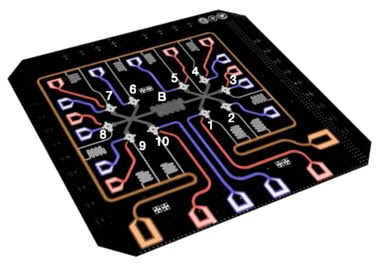 |
| Illustration of the ten-qubit processor (Courtesy: Chao Song et al/ Physical Review Letters) |
Topics: Nanotechnology, Quantum Computer, Quantum Mechanics, Superconductors
Physicists in China and the US have built a 10-qubit superconducting quantum processor that could be scaled up to tackle problems not solvable by classical computers. The performance of the device was verified using quantum tomography, which showed that the new approach can generate a true 10-partite Greenberger–Horne–Zeilinger (GHZ) state – the largest yet achieved in a solid-state system.
The field of quantum computing is in its infancy, and a genuinely useful, practical device that outperforms classical computers has not yet been built. At this stage of development, researchers do not even agree on the basics of implementation, but techniques employing superconducting circuits have an advantage over some other designs in that they are based on established and scalable microfabrication processes.
Superconducting quantum computer achieves 10-qubit entanglement
Marric Stephens, Physics World
Comments